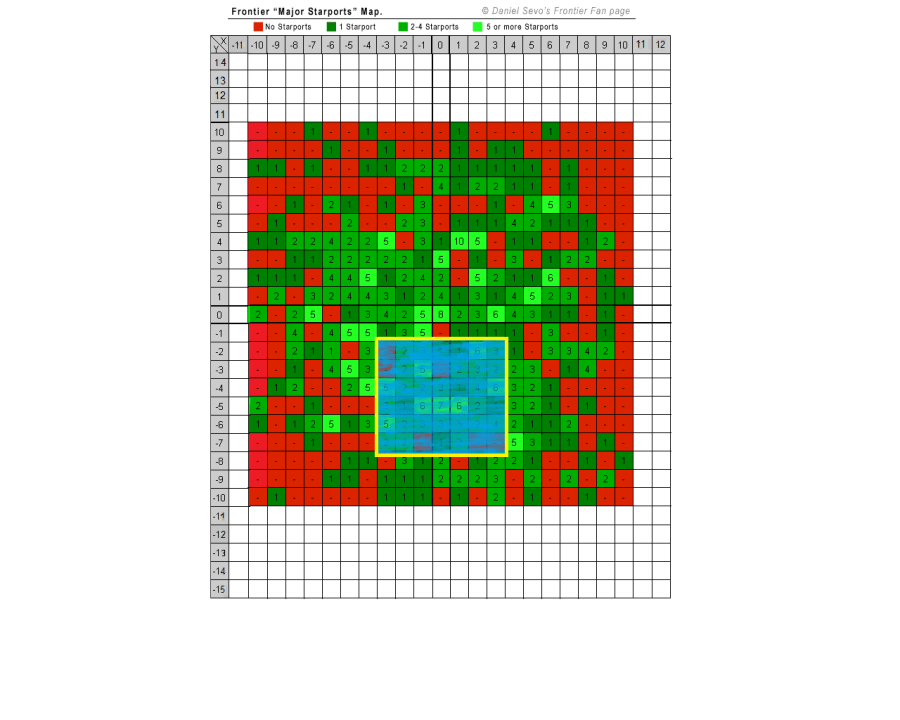Redspear wrote:Lot's of tiny galaxy maps are quite dull; their sense of scale is extremely limited and their significance is questionable when the sytems they generate are from exactly the same set of variables (many of which don't particularly affect the player's experience - 'was it zero-G cricket or zero-G hockey; and come to think of it, after the 100th time, do I care?').
I'm sure someone trading in sporting goods in New Cargoes has made that exact mistake...
Redspear wrote:Very much agree; to the extent that my first galactic hyperjump in elite was a big disapointment
I find the eight galaxies have a very different feel to them.
1 - mostly well connected, but you've got that large bit at 5 o'clock which is almost a separate bit.
2 - lots of bottlenecks. Most of the Eight's double bottlenecks.
3 - similar to 1 in terms of general connectivity, but with that odd disconnection across a lot of the north edge.
4 - odd government types: only four of the eight used, which gives it a lot of Anarchy bottlenecks, especially if travelling east/west.
5 - feels very core+frontier, in a way, with oddities like the Steel Halo or Tetiri Conclave, or the thin route from S to SE
6 - this one just makes me uneasy. I don't know why.
7 - the Great Rift, but even without that divided into two halves with narrow bottleneck routes between them
8 - Oresrati, of course, but also very well connected in terms of routes to reach various points.
The topology is something the core game is trying to make more use of than it does, as you'll see if you try to smuggle the wrong person through the Maorin pass in the next version... (as I've said in different ways elsewhere: Elite by necessity and Oolite by not getting round to it yet make fairly poor use of the diversity already available)
Redspear wrote:but they'd be big enough to give a greater illusion of a galaxy
Perhaps read "Galactic Chart 1" as more like "Galactic Sector 1" than "Chart of Galaxy 1", and "Galactic Hyperdrive" as "hyperdrive which transports you on a galactic scale" not "hyperdrive which transports you on an inter-galactic scale"? The charts aren't near each other, but nor are they each galaxies in their own right. Why they're like they are in identical scale ... well, I have some partial answers on that but I don't expect anyone to believe them.
Redspear wrote:Are possible hyperspace routes created purely by distance between systems?
If so, would stitching 'galaxies' together like this work to create larger galaxies expanding out from the ones we already have?
Can the galaxy number array (if that's the right word) accommodate all these extra sytems?
If not, could this easily be changed or could such arrays be grouped together somehow to function effectively as one galaxy.
Could individaul, newly created sytems be removed if it were necessary to preserve certain mission environments (e.g. access routes to systems)?
1) Yes.
2) Yes, if it was just done by adding new systems at coordinates outside the usual bounds.
3) Theoretically it should just be a matter of changing the systems-per-galaxy constant. In practice there's probably some subtle assumptions elsewhere that will break.
4) That would get messy as currently implemented when the player was near a border. Adding more systems to an existing chart would be easier.
5) Given that we haven't discussed a mechanism for adding these extra systems yet, probably the easier approach would be not to add unwanted ones in the first place. If you're adding systems which weren't in Elite, there's no particularly good reason to exactly mimic Elite's galaxy generation algorithm [1]. But the way connectivity works you would have to be very careful not to (e.g.) join up the great rift, or provide back doors in to various peninsulas, so I think you'd end up with the rectangular borders of the original map still oddly visible in places.
[1] It's unclear whether there's a good reason for Oolite itself to mimic Elite's galaxy generation algorithm in creating the basic eight charts now that there's no longer a need to store the entire galaxy data in a few kilobytes. I suspect on balance getting the same results from a different approach might be advantageous, though I can think of advantages to the current mechanism too (not least: it works, more or less, without some fairly fundamental recoding)
